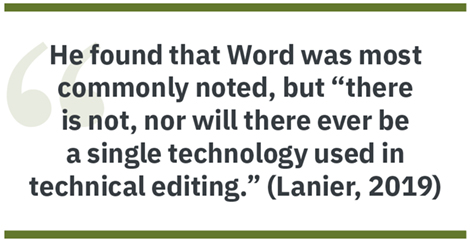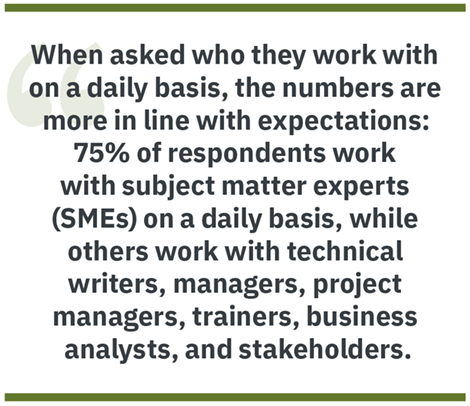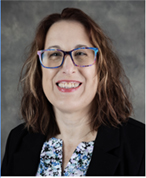By Kelly Schrank | Associate Fellow
A survey to members of the Technical Editing SIG reveals a wide variety of titles, responsibilities, and industries.
Getting a cohesive view of our profession is challenging. The umbrella of technical communication includes many types of work, from writers to editors to instructional designers to illustrators to managers. While the Technical Editing Special Interest Group (TESIG) has historically been one of the most populous and active in STC, that population doesn’t necessarily represent people who ONLY act as technical editors in their functional roles, but technical communicators that also edit.
This is reflected in the makeup of the TESIG. The member list of the TESIG shows 206 members with a wide variety of titles. Of the 141 titles provided by members when they sign up or renew, 69 were technical writers, nine were a technical writer/editor combo, seven were managers, and ten were editors. Other popular titles were professors (4), students (13), directors (3), and business owners (6).
I sent a survey to members of the TESIG (Schrank, 2023) to discover their current practices in our profession. There were only 33 responses, and then I followed up with six more respondents for an in-depth conversation. While this was only a small sampling, which may have also been confounded by non-members seeing and taking the survey when I posted to my social media, it was a broad swath of those identifying as technical editors or doing technical editing. Based on responses, it’s obvious that many folks are not only technical editors. In fact, many folks only mentioned writing, saying they were the sole technical writer, or listing many documentation deliverables.
Many respondents mix these two types of work: 7 considered themselves writers/editors, with one being a project manager/editor. One such writer/editor interviewed for her job as a writer, but then was hired as an editor because of her interest and experience, but now that she’s been there, she finds herself acting as a writer on some projects because of layoffs. She believes you need to be well-rounded and flexible to stay employed, and she doesn’t want to limit herself or her career options by just being an editor.
The number of writers in the TESIG may be related to a change in the work of technical communicators. In the Introduction to Technical Editing, the editor’s note states: “The editing of existing content is edging out the authoring of original content as the main activity of technical communicators.” (Cunningham, Malone and Rothschild, 2020)
Given how many job ads ask for specific software skills for technical communicators, it was surprising that almost half of those surveyed said they edited in Word. The rest were an interesting mix, with the somewhat popular PDF, Excel, and PowerPoint each being mentioned multiple times. Other respondents seem to edit in a multitude of environments, so any of those already mentioned, but then also test environments, online tools, Confluence, FrameMaker, Flare, InDesign, Illustrator, Paint, Google docs, and even paper (though some mentioned in comments that it was a way to see the text differently than on screen, and that they would still need to transcribe edits into electronic files). This dichotomy of Word versus everything else was confirmed in a focus group/study by Clinton R. Lanier, who attempted to find out what types of technologies should be taught in technical editing classrooms. He found that Word was most commonly noted, but “there is not, nor will there ever be a single technology used in technical editing.” (Lanier, 2019)

Many new technologies may be needed by editors just to do their jobs. Two noted that their work comes through JIRA tickets, while others said they are assigned or offered work via shared drives or websites, with email notifications or requests. Many editors find themselves needing to know a little bit about everything: “visual literacy…interaction design…software applications (help authoring, image editing, database management), markup language, and online collaboration tools and social media.” (Cunningham, Malone and Rothschild, 2020)
When asked separately about their editing tools, 49% use checklists, 55% use specific software, 25% use macros, and almost 30% said other, which contained a variety of tools, from online style guides, to Grammarly, to Google.
When asked who they work with on a daily basis, the numbers are more in line with expectations: 75% of respondents work with subject matter experts (SMEs) on a daily basis, while others work with technical writers, managers, project managers, trainers, business analysts, and stakeholders.

When asked what industry they are in, there seemed to be few overlaps in this small sample (33 surveys total). The two most common were healthcare (6), with industries listed as biomedical, medical devices, and biopharmaceutical, and software/hardware/IT (6), described as software development, IT, and cybersecurity. There were two in oil and gas, two in accounting/finance and banking, three in manufacturing, and three in government. And the rest were unique, sometimes because they were the only one to respond like that and sometimes because they were just too generic to be categorized: education, proposals, English language services, scientific and professional services, consulting, energy, academia, and civil engineering and professional services.
When given a broad question, like, How do they fit into the company?, some people’s jobs became more clear. In line with the audience for this survey, 12 mentioned only editing (including formatting and quality, but not writing). Of those I talked to, only one technical editor has what has been traditionally considered a typical editing position, where he is the technical editor for a team of technical writers with a tech comm manager leading the team. Two technical editors are on teams of editors (one large, two small) who edit the work of SMEs in industries as diverse as environmental, toxicology, and research grants.
And how is the job market? A recent search on LinkedIn brought up 11 results for “technical editor” with “remote” as the location; a similar search (without the quotes) brought up 342 results, with many of these being technical writer or technical writer/editor combos (in full disclosure, by page 12 of 14 pages of results, the jobs are more technical than writer or editor). Indeed had similar results, 12 jobs for “technical editor” and 286 jobs for technical editor, which had many technical writer/editor combos.
Talking to technical editors throughout the years, I often hear that you need to be open to writing or completing other types of tasks in order to stay busy in a full-time position, or even as a freelancer. Given that a typical editor can edit the work of 7-20+ writers (though I often hear 1:12 is the optimal ratio), the demand for technical editors is much less than that for technical writers, but that doesn’t mean they are not necessary or sought after in industry.
References
Cunningham, Donald H., Edward A. Malone, and Joyce M. Rothschild. 2020. Technical Editing: An Introduction to Editing in the Workplace. New York: Oxford Univisity Press.
Lanier, Clinton R. 2019. “Concepts in Technical Editing: What’s Important in Practice?” In Editing in the Modern Classroom, by Suzan Flanagan and Michael J. Albers, 138,143. New York: Routledge.
Schrank, Kelly. 2023. “Current State of Technical Editing.” https://www.surveymonkey.com/r/3QMZXDX.
 Kelly Schrank, MA, ELS, (kelly@headbookworm.com) has been a technical editor for almost 30 years and a medical editor for 13 years. She runs Bookworm Editing Services and enjoys sharing her knowledge and experience about topics like editing, checklists, Microsoft Word and PowerPoint, infographics, side gigs, and networking.
Kelly Schrank, MA, ELS, (kelly@headbookworm.com) has been a technical editor for almost 30 years and a medical editor for 13 years. She runs Bookworm Editing Services and enjoys sharing her knowledge and experience about topics like editing, checklists, Microsoft Word and PowerPoint, infographics, side gigs, and networking.


